25 JANUARY – 07 FEBRUARY 2025
By Fraser Bell
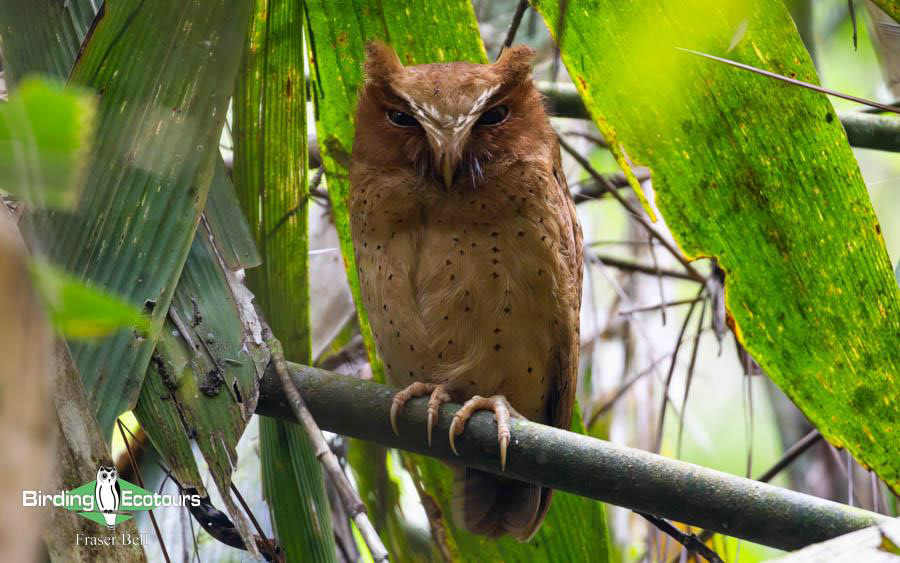
The recently described endemic Serendib Scops Owl gave us incredible views and was rightly voted bird of the trip. This is a top target on our Sri Lanka birdwatching tours and it was great to connect with the bird on our first afternoon in the dense forests of Sinharaja.
Overview
This birding tour of Sri Lanka began in Colombo on the 25th of January 2025, and concluded there on the 7th of February 2025. The tour focus was to see all 35 of the country’s currently recognized endemic bird species (which we did), along with several near-endemics found only in Sri Lanka or nearby southern India, and key migrant birds. We also enjoyed encounters with some impressive mammals, including Sloth Bear and Asian Elephant during our time in the dry zone, and cetaceans on a pelagic trip in the Indian Ocean.
The tour began with some introductory birding around our hotel near the airport, before targeting 28 of Sri Lanka’s endemics found in the wet lowland forests. We first explored the more open forest-garden habitats of Kitulgala, then moved on to the dense, lush rainforests of Sinharaja, where fast-paced birding among mixed-species flocks was a real highlight. From there, we headed south to the coast at Mirissa, enjoying some wetland birding and a whale-watching trip before continuing east into the dry and arid landscapes of southern Sri Lanka. In addition to the two dry-zone endemic bird species, we were on the lookout for mammals, as well as open-country and wetland birds during three exciting game drives in Bundala, Yala, and Uda Walawe National Parks. We then spent two nights in the highlands seeking the final five endemics and several rare migrants that winter almost exclusively in Sri Lanka’s highlands, at Horton Plains National Park and Victoria Park. Our final birding was around Kandy, where we enjoyed catching up with a few species first encountered at the start of the tour.
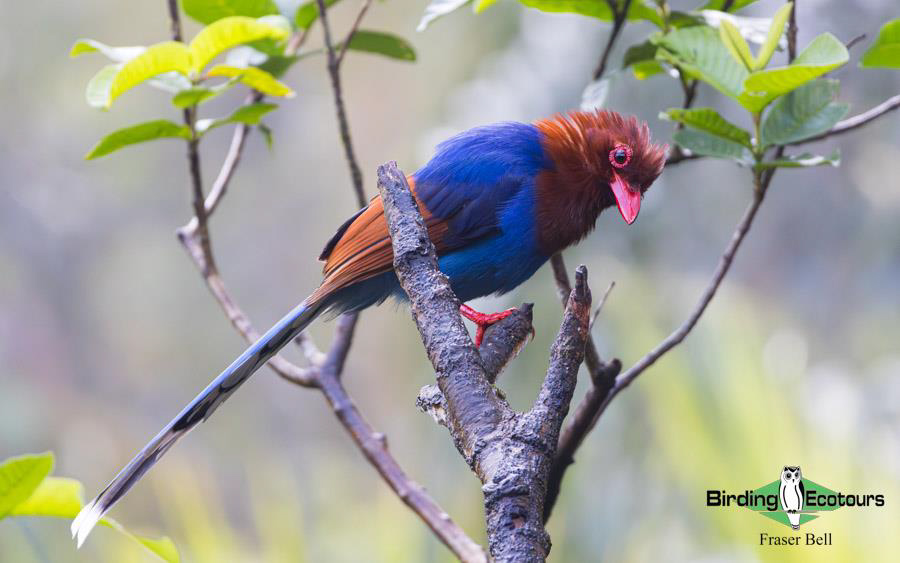
Sri Lanka is home to many beautifully colored species, like the iconic Sri Lanka Blue Magpie.
We recorded 242 bird species on this Sri Lanka birdwatching tour, with one species heard only. Highlights included seeing all 35 of Sri Lanka’s endemic bird species, including Sri Lanka Spurfowl, Green-billed Coucal, Red-faced Malkoha, Sri Lanka Wood Pigeon, Sri Lanka Blue Magpie, Sri Lanka Bush Warbler, Sri Lanka Thrush, Sri Lanka Scimitar Babbler, Sri Lanka Shama, Sri Lanka Whistling Thrush, and as well as species found only in Sri Lanka or India, including Sri Lanka Frogmouth, Blue-faced Malkoha, Marshall’s Iora, and Loten’s Sunbird. We also enjoyed seven owl species (including the most wanted Serendib Scops Owl), a variety of waterbirds, and rare migrants such as the striking Kashmir Flycatcher and Pied Thrush.
In addition to the exceptional birding, we encountered an exciting range of other wildlife, including mammals like Sloth Bear, Wild Water Buffalo, Short-finned Pilot and Fin Whales, Indian Giant Flying Squirrel, Golden Jackal, and the endemic Purple-faced Langur. We also encountered a few endemic reptiles such as Sri Lankan Flapshell Turtle, Lyre Head Lizard, and Wiegmann’s Agama.
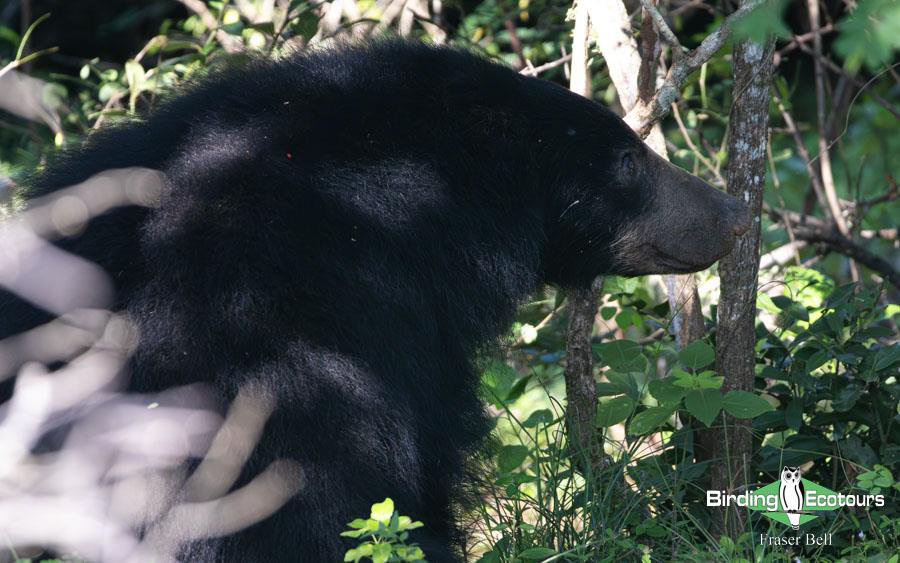
Seeing this Sloth Bear during a game drive at Yala National Park was a real tour highlight!
Bird and animal lists for this Sri Lanka birding tour follow the report and you can also view the eBird trip report here, where you can see more bird photos.
Detailed Report
Day 1, 25th January 2025. Arrival in Katunayake, and an introduction to birding in Sri Lanka
Most of the group had arrived early and enjoyed a leisurely morning at the hotel before we met up and birded the hotel gardens and a small overgrown pool nearby. It was a lovely introduction to birding in the Indian Subcontinent, and we began by enjoying some of the common species that would accompany us throughout the tour. These included Indian Paradise Flycatcher, Brown-headed Barbet, Rose-ringed Parakeet, Booted Eagle, an uncommon migrant in Sri Lanka, and a nesting pair of Shikras. Standout birds included a trio of species endemic to Sri Lanka, with a pair of Red-backed Flamebacks, a Crimson-fronted Barbet at the top of the canopy, brief views of Sri Lanka Swallow, and a pair of near-endemic Loten’s Sunbirds feeding on flowering shrubs right outside our rooms. Over our first of many tasty Sri Lankan rice and curry meals, we discussed the upcoming tour and our top bird and animal targets for the next two weeks.
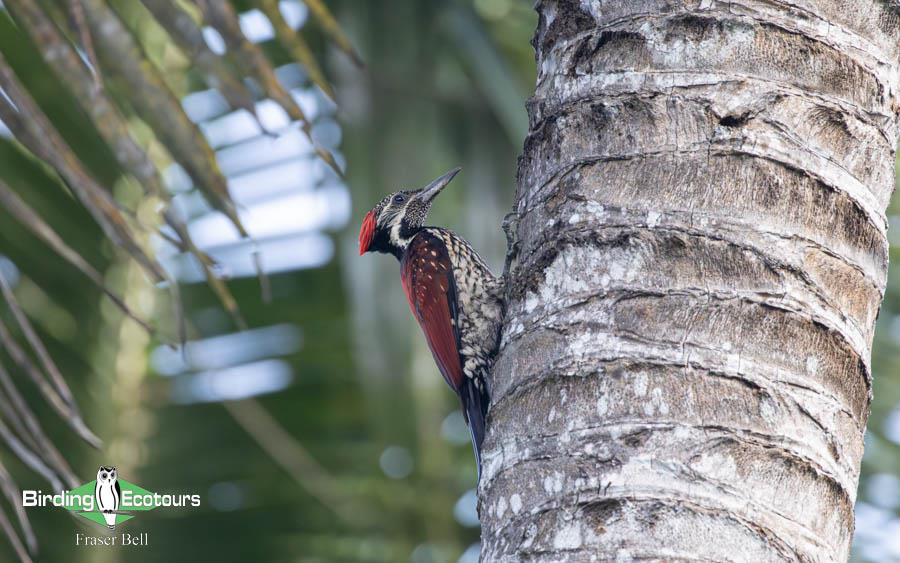
The endemic Red-backed Flameback gave us a warm welcome to Sri Lanka, with excellent views of a pair in our hotel grounds.
Day 2, 26th January 2025. Transfer to Kitulgala and birding for lowland endemics and special
After a leisurely breakfast, we spent the morning transferring to the wet lowlands around Kitulgala. This marked our transition into Sri Lanka’s lush wet zone, where dense lowland rainforests host the majority of the island’s endemic species. A few well-timed birding stops during the transfer provided brilliant views of a pair of Black Eagle, one of which glided low over the canopy, sending a troop of Toque Macaques into a panic. Other raptors included our first of many Crested Honey Buzzards, Crested Serpent Eagles, and a Changeable Hawk-Eagle. Birding from a quiet bridge over a small river surrounded by open forest gave us great views of White-rumped Munia, Small Minivet, a brief flyover by several Sri Lanka Hanging Parrots, and Southern Hill Myna. Our destination was a secluded eco retreat nestled in forest north of Kitulgala. To reach it, we left the bus and took a short tuk-tuk ride down a steep slope, which was an entertaining way to begin and end each day while based here! After a delicious lunch, we headed back out into the Kitulgala forests with several endemic targets in mind.
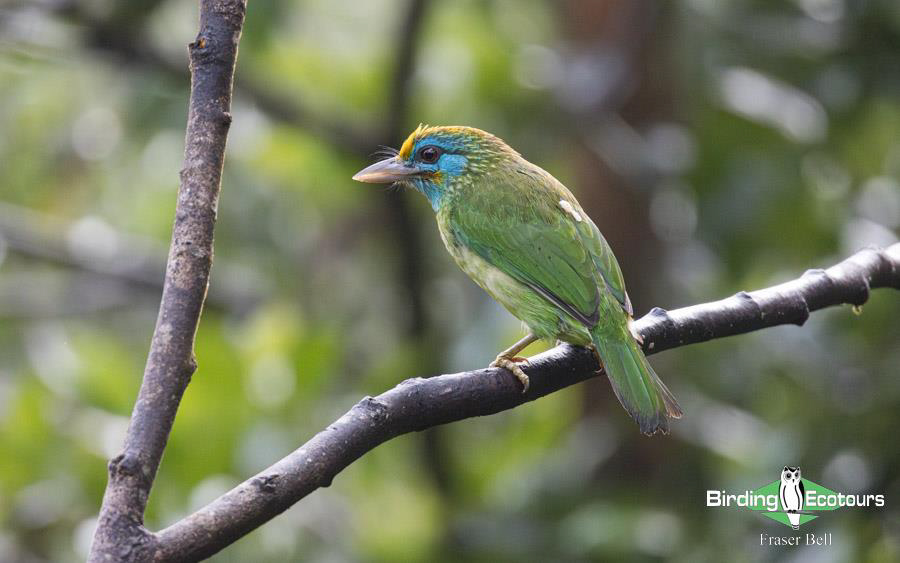
The Yellow-fronted Barbet is a striking endemic and a familiar sight and sound in Sri Lanka’s wet zone.
On arrival in the open forests of Kitulgala, we quickly picked up the endemics Sri Lanka Grey Hornbill, Yellow-fronted Barbet, and Orange-billed Babbler, along with the striking Orange Minivet, a male Golden-fronted Leafbird, and several perched Sri Lanka Hanging Parrots, a satisfying follow-up to the brief in-flight views that morning. Crashes in the forest revealed a small troop of Purple-faced Langur, a widespread species in Sri Lanka but these were from the rare nestor subspecies. Birding along a shaded forest stream did not produce the hoped-for Black-backed Dwarf Kingfisher, but a trio of flycatchers, Asian Brown, Brown-breasted, and Tickell’s Blue Flycatchers were a pleasure to watch, with the vivid colors of the latter lighting up the dark understory. Our first full day ended with a great meal and a well-earned beer at our peaceful eco retreat.
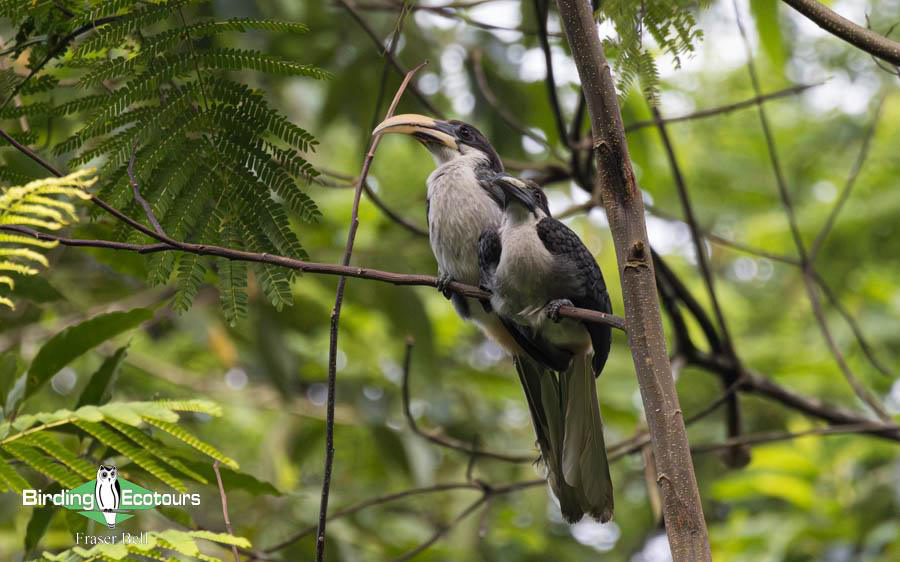
This pair of Sri Lanka Grey Hornbill put on quite the display for us, preening and courting just outside our rooms.
Day 3, 27th January 2025. Full day birding in Kitulgala for lowland endemics and specials
An early start saw us back in tuk-tuks going up the hill from our eco retreat before driving back down into Kitulgala. This time, luck was on our side and we saw the beautiful Chestnut-backed Owlet, which gave brilliant views as it peered down at us from the canopy. For some in the group, this was quickly followed by a sighting of the endemic Brown-capped Babbler which almost walked under some people’s feet, and a Grey-bellied Cuckoo, rare in the wet lowlands, which disappeared quickly, following after a group of bulbuls and Golden-fronted Leafbird. While we could hear Black-backed Dwarf Kingfisher, by the time we reached the forest streams where it had been calling from, it had already moved on.
Our packed breakfast and coffee really hit the spot, and afterwards we crossed a wide river to bird the gardens and crop fields of tea and coffee beyond. The birding here was excellent and fast-paced, and with open mixed forest the species diversity was high. We saw Sri Lanka Junglefowl, Black-naped Monarch, Common Iora, Dark-fronted Babbler, Chestnut-headed Bee-eater, and White-browed Fantail among many others. The best though was a stunningly beautiful male Indian Paradise Flycatcher of the migratory pure white type, and a duo of Indian Pitta that most of the group got onto, especially when one individual flew in and landed on an open horizontal branch near us.
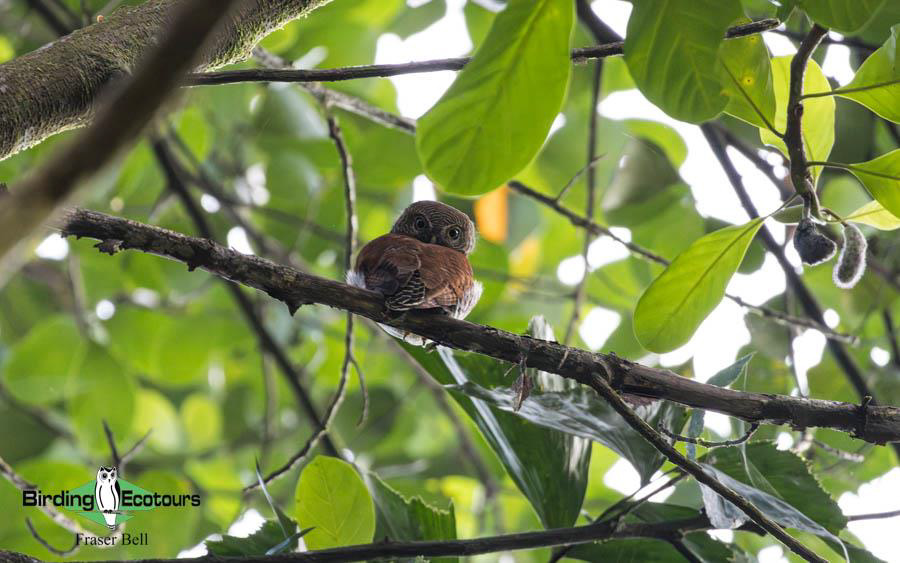
The endemic Chestnut-backed Owlet was our first nocturnal bird of the trip and a real crowd pleaser as it watched us intently from its perch.
We enjoyed a well-earned lunch of Sri Lankan curry while overlooking the Kelani River, then headed back to the eco retreat for a bit of time off during the heat of the day. Given the rooms had balconies overlooking forest bordering a river beyond, most opted to spend their down time birding from their balconies or taking pictures of the endemic Lyre Head Lizard and Wiegmann’s Agama which lived outside the restaurant.
Considering the morning’s success, we decided to bird along the quiet roads near our accommodation, which gave excellent views into the forest edge and at times down into the canopy below. This proved to be a great decision and we added four more of Sri Lanka’s endemic birds to our growing trip list. One of the first was a pair of Spot-winged Thrushes feeding on rice and scraps under a house, which we ended up revisiting for even closer views. Layard’s Parakeets were constantly flying overhead throughout the afternoon, though we eventually had excellent views of a large group feeding in a nearby jackfruit tree. Other highlights included our first Sri Lanka Scimitar Babbler and a group of Sri Lanka Green Pigeons coming to roost.
Day 4, 28th January 2025. Drive to and birding the endemic hotspot Sinharaja Forest Reserve
A more relaxed morning started with some birding from our balconies and a great breakfast. We did not have many notable sightings on our morning transfer to Sinharaja, but a mid-point coffee break really hit the spot. On arrival at our accommodation, we were struck by the sweeping views of the surrounding lush forest and low cloud clinging to the hills, and were equally impressed by the eco lodge itself. Set on a small hill overlooking tea fields and rainforest, our eco lodge was very comfortable, and right in the middle of the action. Over lunch we discovered the food was great too.
Our afternoon birding session started with an absolute cracker of a bird, as we saw Serendib Scops Owl, an endemic only described in 2004 and named after one of the old names for Sri Lanka. We were able to get close to this special endemic at its day roost (see the cover image). Afterwards, an hour of road birding along a hillside was very productive and we added the endemic Crimson-backed Flameback, plus Black-hooded Cuckooshrike, Crested Treeswift, and Banded Bay Cuckoo, among others, and improved views of some nice endemics including perched Sri Lanka Swallow. Given our success and the effort needed to find the scops owl which involved a bit of an uphill scramble through the forest, we wrapped up the afternoon a little early and headed back for a well-earned relax and a drink.
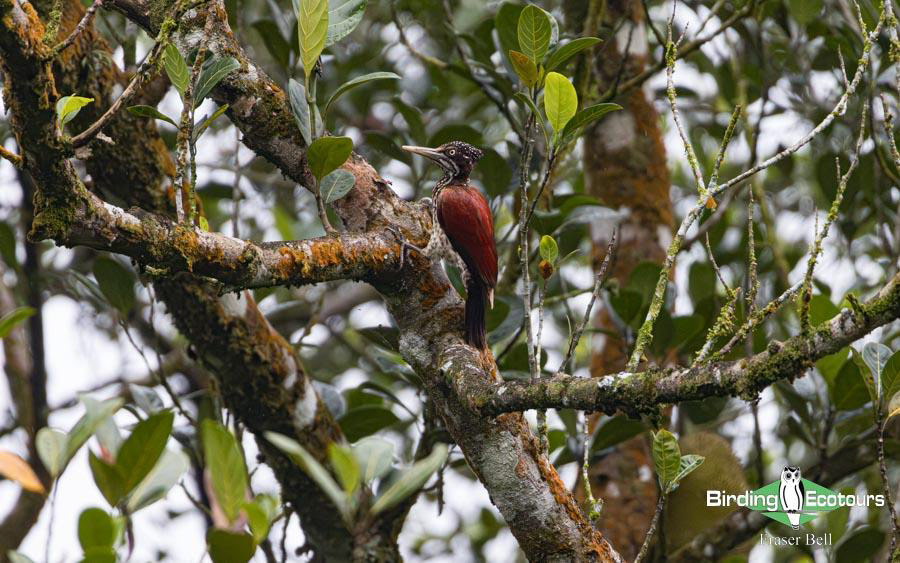
The larger of Sri Lanka’s two endemic woodpeckers, Crimson-backed Flameback is an impressive bird, and we had repeated views of these during the tour.
Day 5, 29th January 2025. Birding Sinharaja for lowland wet-zone endemics
In the early light we got into our jeeps and headed along a bumpy forest track, arriving at a clearing in the dense forest. Here a small house doubles as a stakeout for some seriously cool birds that can otherwise be secretive and hard to see. With a bit of patience we saw both of our main endemic targets; a pair of Sri Lanka Spurfowls which we were able to watch for some time, and a small group of roving Ashy-headed Laughingthrushes. Also in attendance was a female Indian Blue Robin, Spot-winged Thrush, Sri Lanka Junglefowl, and Common Emerald Dove. Between birding we enjoyed our packed breakfast and hot coffee and kept finding great birds by watching the forest surrounding the clearing. Here we saw Sri Lanka Hill Myna, Black-capped Bulbul, Sri Lanka Drongo, Legge’s Flowerpecker, Black-throated Munia, Velvet-fronted Nuthatch, Brown-capped Pygmy Woodpecker, and three roosting Sri Lanka Frogmouths.
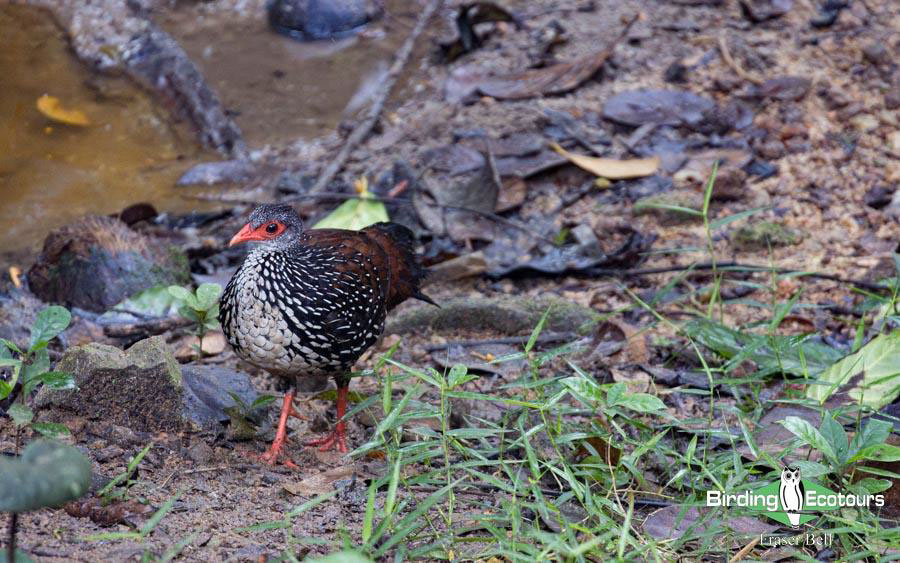
Sri Lanka Spurfowl are shy and sensitive, so we were pleased to see a pair on two consecutive days.
After some well-deserved down time we headed to the main visitor center where we quickly saw the resident pair of colorful Sri Lanka Blue Magpies and had great views. For the rest of the afternoon we birded in the center of the village, checking home gardens and forest scrub in search of a tricky endemic.
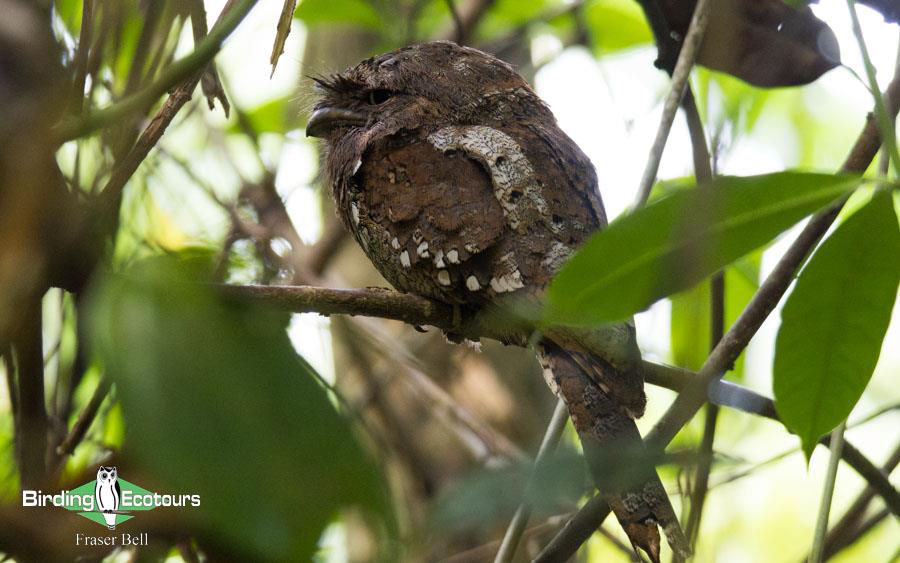
Sri Lanka Frogmouth also occurs in southern India, but is satisfyingly common in Sinharaja, where we saw half a dozen perched at their day roosts. At night we could also hear their bizarre calls from the eco lodge.
At first we had better views of Brown-capped Pygmy Woodpecker, Sri Lanka Drongo, and Legge’s Flowerpecker, and a brief look at Sri Lanka White-eye, though these moved off quickly. Luckily for us some bulbuls mobbed a Chestnut-backed Owlet, which flew in right next to us and gave fantastic views again. We tried a few different spots and eventually found our afternoon target of Green-billed Coucal skulking in some dense bamboo and scrub, another tough endemic in the bag.
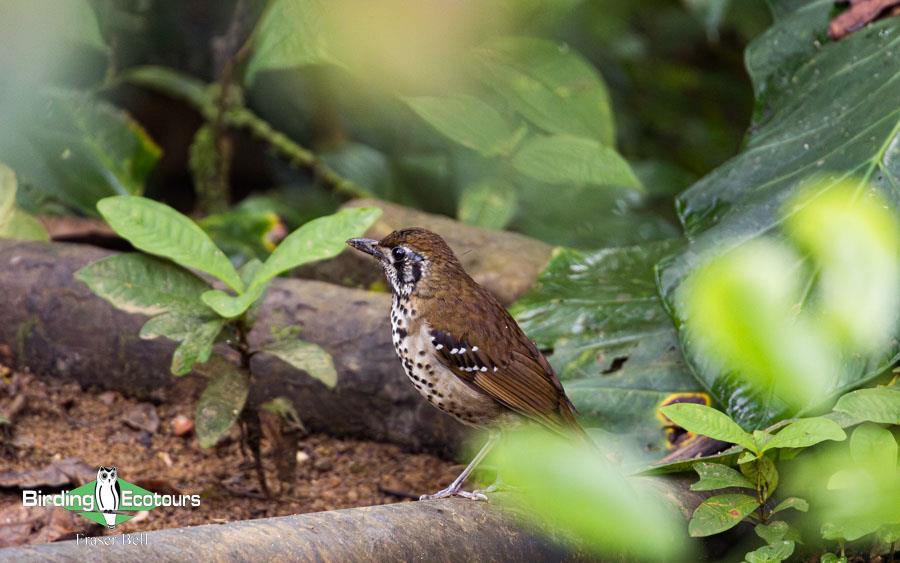
Spot-winged Thrush is the most common of Sri Lanka’s endemic thrushes, but it still remains a real skulker.
Day 6, 30th January 2025. Birding Sinharaja and the last of the wet-zone birding
Today we spent the morning in the dense primary forests of Sinharaja. It took some time to reach our destination along steep boulder-strewn roads, which made for an entertaining jeep ride. Our first stop did not produce the hoped-for Sri Lanka Thrush and was fairly quiet, so we’d have to keep looking for this big target. On arrival at our breakfast spot we scored another endemic, as White-faced Starlings were actively feeding in the canopy with Orange-billed Babbler, Square-tailed Bulbul, and Common Iora. A group of Sri Lanka White-eyes gave eye-level views before quickly joining the small canopy flock. Over breakfast we had close views of Sri Lanka Spurfowl, Sri Lanka Blue Magpie, and Yellow-fronted Barbet at a feeding station, along with other regulars and an endemic Layard’s Palm Squirrel. We also got lucky when a female Malabar Trogon flew in above us and the whole group was able to enjoy scope views. The highlights of the morning were still to come though, as we spent half an hour enjoying occasional but good views of Sri Lanka Thrush quietly foraging along the edge of a forest stream. Later we encountered two busy mixed species flocks, and the larger one crucially contained Red-faced Malkoha. A celebratory drink in the forest followed as we toasted our success in finding all of Sri Lanka’s wet forest endemics!
After a particularly enjoyable lunch, our afternoon session was accompanied by the sound of thunder and cut short by rain, but we still enjoyed seeing good numbers of Blue-tailed Bee-eaters, Sri Lanka Swallows, and Layard’s Parakeets before the rain started.
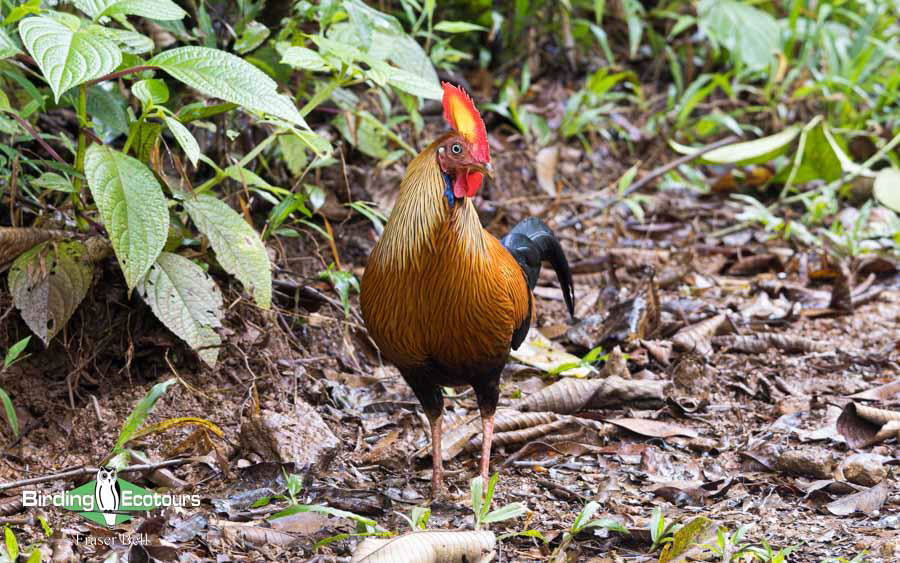
It’s satisfying to catch the yellow flare in a male Sri Lanka Junglefowl’s comb. These birds are common across much of the island and while searching for Sri Lanka Thrush we had to watch our step as they fed right among us!
Day 7, 31st January 2025. Traveling south to coastal Mirissa and wetland birding
For the early risers we added Blyth’s Reed Warbler, Brown Shrike, and Plum-headed Parakeet on a pre-breakfast walk near our eco lodge before setting off and traveling south to Mirissa and the coast. Our accommodation was a plush beachfront resort. We made the most of this location and birded from the beach, picking up large numbers of Little Tern, plus a few Gull-billed and Whiskered Terns, Brown-headed Gull, and both Common and Stork-billed Kingfisher. The afternoon outing was great fun and gave us our first wetland birding of the trip where we saw almost 60 species in just two hours at the Kirala Kele Sanctuary. While we added many species to our list, the highlights included both Yellow and Cinnamon Bitterns, along with Pheasant-tailed Jacana, Grey-headed Fish Eagle, and even a rare migrant – a lone Knob-billed Duck for the few who got on it.
Day 8, 1st February 2025. Morning whale-watching tour, afternoon travel to and birding Tissamaharama
While some in the group opted for more land-based birding, revisiting the wetlands from the previous afternoon, most set off early for the Mirissa harbor to board a boat for a whale-watching trip. The water here is usually calm and several cetacean species are seen regularly, making it an enjoyable outing. First up was a pod of Spinner Dolphins, which lived up to their name and occasionally spun out of the water. The highlight was a large mixed pod of Short-finned Pilot Whales and Indo-Pacific Bottlenose Dolphins, which we all saw incredibly well as they breached around us and spy-hopped between the boats. After this we had a brief encounter with a Fin Whale which is relatively rare here, but the boat’s propeller broke and we had to unfortunately limp back to shore. Considering the main focus was the cetaceans, we were happy to see five species of tern, adding Greater Crested and White-winged Terns to our growing trip list.
We reunited with the other group who had improved views of many wetland species seen the previous afternoon, then headed east to the Tissamaharama (Tissa) area. After checking in to our fantastic hotel – which many of us agreed was one of the best we had ever stayed in – we had a very productive afternoon birding around Tissa. We started by visiting three gardens where locals had found roosting owls. One after another we saw Indian Scops Owl, Jungle Owlet, and Brown Boobook, the first of which showed particularly well and ended up as a runner-up for bird of the trip. After this enjoyable run around we spent the rest of the afternoon birding wetlands. A trio of endemic Sri Lanka Woodshrikes gave great views and we also enjoyed seeing Jerdon’s Leafbird, White-naped Woodpecker, and Thick-billed Flowerpecker. We finished the day watching Indian Flying Foxes leaving their roost against the sunset, with nice views of Eastern Barn Owl at dusk, and another round of incredible Sri Lankan food.
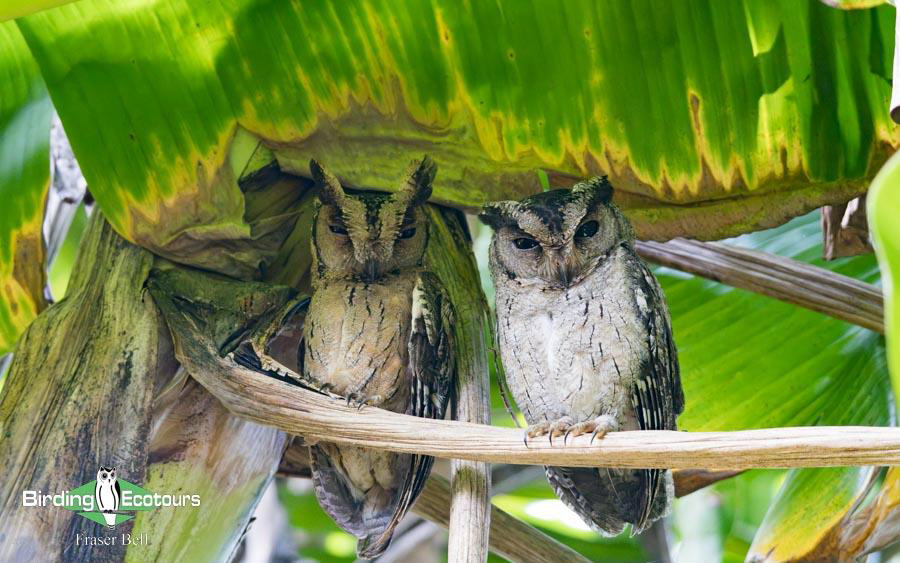
This pair of Indian Scops Owls were a lovely sight, especially with both brown and grey color morphs side by side and at such close range. They became a real contender for bird of the trip.
Day 9, 2nd February 2025. Morning birding at Bundala National Park, afternoon at Tissamaharama Wetlands
We spent a long morning at the absolutely brilliant Bundala National Park which was packed with birds. Exploring the wetlands, salt pans, and scrub by jeep is easily one of the highlights of our Sri Lanka tour and between the group we logged over 100 species before lunch! The highlights included Oriental Pratincole, Great Stone-curlew, Yellow-eyed Babbler, and Greater Painted-snipe to name a few, plus loads of shorebirds (waders), herons, storks, kingfishers, and terns, and even a brief view of the shy Watercock. While many of these species were not new for the group, since most are migratory or fairly widespread, the birding was still great fun thanks to the sheer abundance and diversity of birds. We also saw an impressive Saltwater Crocodile and some Bengal Monitor Lizards.
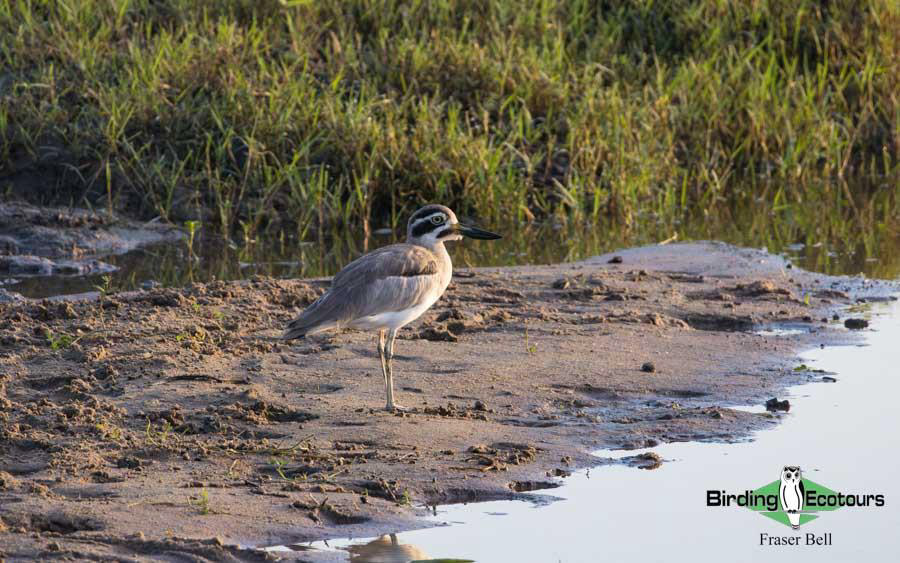
One of the many highlights at Bundala National Park was getting close views of Great Stone-curlews.
That afternoon we had a few hours to enjoy some great food and relax during the heat of the day, before heading back out to the wetlands around Tissa. Unfortunately we did not find the local Brown Fish Owl, but we had fun adding both Baya and Streaked Weavers, along with Cotton Pygmy Goose and several other waterbirds, and the endemic Sri Lankan Flapshell Turtle. We finished the day looking for nightjars flying at dusk, and succeeded in seeing Indian Nightjar, along with Indian Thick-knee and Alexandrine Parakeet.
Day 10, 3rd February 2025. Yala National Park, then Uda Walawe National Park for dry-zone specials
Filled with anticipation we left in the dark with a packed breakfast heading for a game drive in the famous Yala National Park. Unlike the other parks we visit on the tour, the main targets here are actually the large mammals but the birding is also great. Our first stop targeting Jerdon’s Nightjar wasn’t successful, but a lone Ashy Drongo and good views of a pair of endemic Brown-capped Babblers made up for it. The birding inside the park was fun and after some time trying, we eventually all got onto Sri Lanka Shama which were adept at keeping hidden in the dense scrub. Other highlights included Grey-bellied Cuckoo, Asian Woolly-necked Stork, and Yellow-crowned Woodpecker. Still it was the mammals that stole the show as we saw Golden Jackal, Tufted Grey Langur, Wild Boar, Wild Water Buffalo, Sri Lankan Giant Squirrel, Sambar deer, and Chital (Spotted Deer), and we had an amazing close encounter with a rarely seen Sloth Bear. We had great views as this fluffy lump nimbly climbed a scrubby tree and delicately picked berries off the branch tips while hanging upside down – which was impressive for its size!
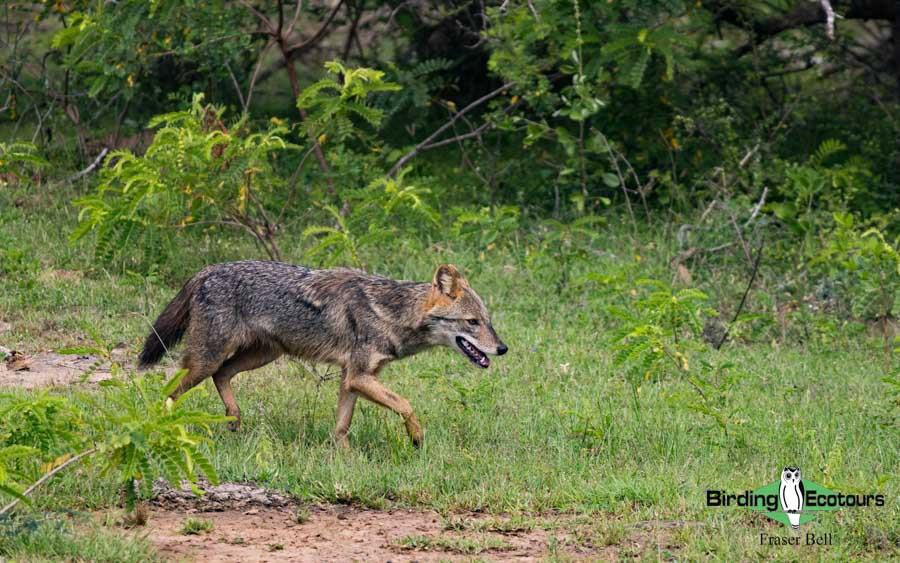
Golden Jackal was one of 14 mammal species we saw during a game drive in Yala National Park.
After an eventful morning we drove northwest for our one-night stay in the Uda Walawe area. We checked in and had a nice lunch then prepared for our third and final game drive. Given our success over the previous few mornings, our main targets were a handful of arid zone species found in the dense scrub here. We had an enjoyable game drive with great views of both Sirkeer and Blue-faced Malkohas and most of the group saw the widespread yet tough-to-see Marshall’s Iora alongside Barred Buttonquails, Orange-breasted Green Pigeons, Malabar Pied Hornbills, Jungle Prinias, and Forest and Eastern Yellow Wagtails. Not to mention, enjoying several Asian Elephants during our drive. On the way back to the hotel we stopped on a quiet road and had an efficient session searching for dusk-flying nightjars, as both Jerdon’s and Indian Nightjars were seen well in the dusk light within minutes. Tired, after a long but fun day, we enjoyed some great Sri Lankan food and some celebratory drinks.
Day 11, 4th February 2025. Transfer to Nuwara Eliya and high-elevation birding
After a relaxed breakfast we birded an area near Uda Walawe park, visiting the shoreline of the Uda Walawe Reservoir and some nearby dry scrub forest. This was a surprisingly diverse area and here we saw our only Brown-backed Needletail and Citrine Wagtail of the tour, along with improved views of Marshall’s Iora and Greater Painted-snipe, among others. Given our success in the arid zone we then headed north and climbed into Sri Lanka’s highlands.
Our first stop was a pre-lunch visit to the Surrey Estate where we saw a roosting Brown Wood Owl, though unfortunately it was very wary so we didn’t see it perched for long before it flew across the valley and out of sight. While looking for the owl we happened upon a Rufous Woodpecker which was a great addition for the few that saw it before it hitched up into the high canopy. We also saw our first Cinereous Tit and Peregrine Falcon of the trip, the latter being the endemic subspecies peregrinator. We continued up into the mountains but a chance encounter with a raptor had us scrambling out of the bus as a Rufous-bellied Eagle circled on the thermals first at eye level before climbing higher. This smart raptor has a fairly widespread distribution throughout Southeast Asia, but is uncommonly seen in Sri Lanka.
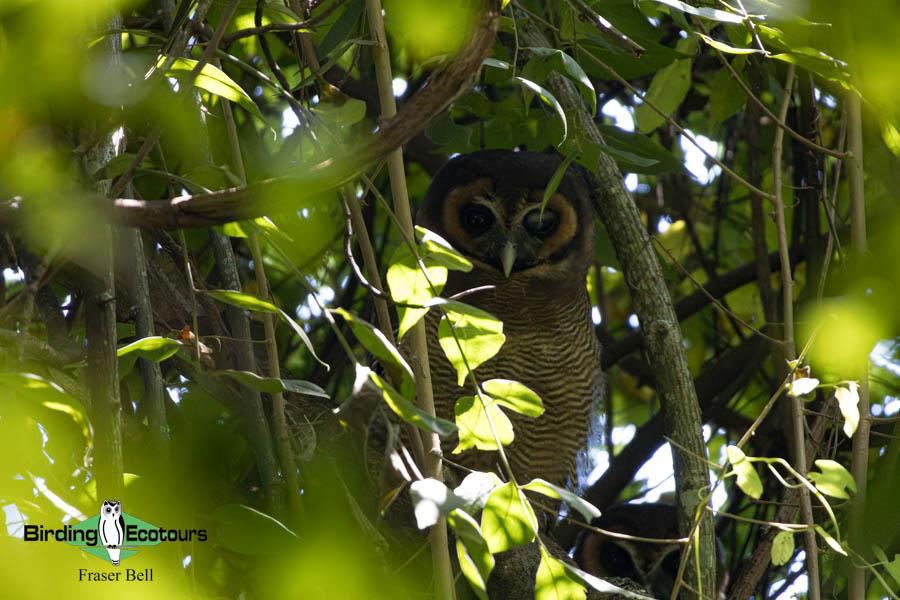
Brown Wood Owls have subtle, beautiful plumage.
We arrived in Nuwara Eliya, a city known for tea growing, a cool climate, and colonial-style architecture, and checked in to our grand hotel for a two-night stay. Afterwards we visited some cloud forest on the outskirts of the city. This proved fairly quiet, but we did eventually get good views of endemic Dull-blue Flycatcher, Yellow-eared Bulbul, and Sri Lanka White-eye, and a few Grey-headed Canary-flycatchers in the mixed species flocks, and a Dusky Striped Squirrel. A chance sighting of a Sri Lanka Thrush and a pair of Indian Blackbirds was frustratingly brief for some.
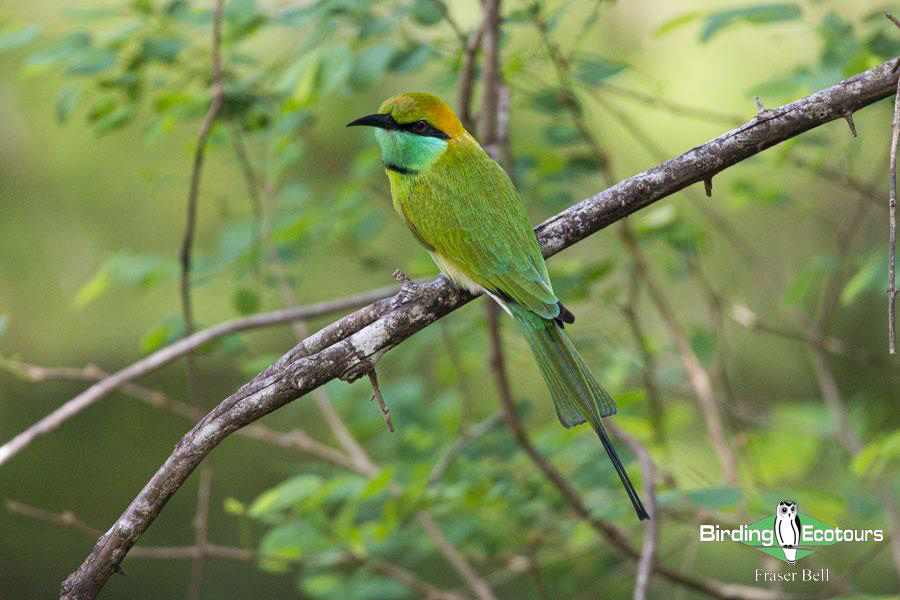
Many of Sri Lanka’s common bird species are colorful, like this Asian Green Bee-eater.
Day 12, 5th February 2025. Nuwara Eliya, looking for montane endemics and other specials
We set off in the early hours in a pair of minibuses which climbed up into Horton Plains National Park, a large area protecting montane grassland and cloud forest along with its wildlife communities. Here we hoped to encounter the final three Sri Lankan bird endemics. While waiting for the park to open we saw a male Indian Blackbird feeding in the dawn light, then, at our first stop we saw five endemic Sri Lanka Wood Pigeons commuting over the cloud forest and luckily one perched up for a while to give great views. We also found a pair of Sri Lanka Bush Warblers which we had brief glimpses of as they scrambled through low shrubs alongside a pool. We got our final endemic, the secretive Sri Lanka Whistling Thrush at the next stop after a bit of a search. Over the course of an hour and a half everyone had good views of two whistling thrushes as they hopped and crept in the vegetation around the pool. This area was great for birding and we had multiple mixed flocks of high elevation songbirds including Dull-blue Flycatcher, Yellow-eared Bulbul, Sri Lanka White-eye, and both Green and Large-billed Leaf Warblers. Given our early success, we spent the remainder of the morning exploring the open grasslands of the plains seeing Pied Bush Chat, Hill Swallow, Himalayan Buzzard, and impressive Sambar deer, though try as we might we couldn’t locate the near-endemic Legge’s Hawk-Eagle.
That afternoon we went to the local Victoria Park, situated in the middle of Nuwara Eliya. Birding the park was a very pleasant experience and we had great views of both of our targets Kashmir Flycatcher and Pied Thrush. These species are rare migrants that breed in the Himalayas and almost exclusively spend the winter months in Sri Lanka, which makes for a special experience enjoying some relaxed birding with these two stars.
Day 13, 6th February 2025. Drive to Kandy, in the afternoon local birding
Given the success of our previous day and having seen all of Sri Lanka’s 35 bird species currently recognized as endemics, and the rare migrants we were targeting in the area, we enjoyed a leisurely breakfast before checking out and heading north towards Kandy. A coffee stop offered epic panoramic views over tea fields, and the hills beyond, made even better by Hill Swallow buzzing around above us.
We checked into our eco lodge for the final night before heading to a local forest park in the center of Kandy. While it doesn’t have a truly wild feel to the forest at Udawatta Kele Sanctuary, it is surprisingly peaceful and diverse considering it is surrounded by the city of Kandy. Highlights here were our best views of Sri Lanka Shama, along with Northern Red Muntjac and Oriental Rat Snake. Our last meal together was fun as always and a few headed out spotlighting and found Indian Giant Flying Squirrel and Common Palm Civet.
Day 14, 7th February 2025. Birding around Kandy, transfer to Katunayake for departure
The final day started with some birding around our eco lodge and while we managed views of the hoped-for Indian Pitta, they unfortunately didn’t show well. Other highlights included Common Hawk-Cuckoo and perched Alexandrine Parakeet. After a transfer and a final lunch together we said our goodbyes which was made easier as most of the group were headed onwards for our Andaman Islands birding trip!
Overall, we saw 241 species in our 14 days together and while there were many avian (and some reptilian) contenders for bird of the trip, Serendib Scops Owl was awarded the top place. Honorable mentions went to the beautiful Kashmir Flycatcher, Red-faced Malkoha, and the pair of cute Indian Scops Owl. Sri Lanka was great fun and what an amazing bunch of birders to experience it with. I can’t wait to bird with you all again sometime soon.
Bird List – Following IOC (Version 14.2/August 2024)
All species were seen, aside from the birds marked with (H) after the common name, which were ‘heard only’.
The following notation after species names is used to show conservation status following BirdLife International: EN = Endangered, VU = Vulnerable. (Endemic) = Sri Lankan endemic birds.
| Common Name | Scientific Name |
| Ducks, Geese and Swans (Anatidae) | |
| Lesser Whistling Duck | Dendrocygna javanica |
| Knob-billed Duck | Sarkidiornis melanotos |
| Cotton Pygmy Goose | Nettapus coromandelianus |
| Pheasants and Allies (Phasianidae) | |
| Indian Peafowl | Pavo cristatus |
| Sri Lanka Spurfowl (Endemic) | Galloperdix bicalcarata |
| Sri Lanka Junglefowl (Endemic) | Gallus lafayettii |
| Nightjars (Caprimulgidae) | |
| Jerdon’s Nightjar | Caprimulgus atripennis |
| Indian Nightjar | Caprimulgus asiaticus |
| Frogmouths (Podargidae) | |
| Sri Lanka Frogmouth | Batrachostomus moniliger |
| Treeswifts (Hemiprocnidae) | |
| Crested Treeswift | Hemiprocne coronata |
| Swifts (Apodidae) | |
| Indian Swiftlet | Aerodramus unicolor |
| Brown-backed Needletail | Hirundapus giganteus |
| Asian Palm Swift | Cypsiurus balasiensis |
| Little Swift | Apus affinis |
| Cuckoos (Cuculidae) | |
| Green-billed Coucal (Endemic) – VU | Centropus chlororhynchos |
| Greater Coucal | Centropus sinensis |
| Sirkeer Malkoha | Taccocua leschenaultii |
| Red-faced Malkoha (Endemic) – VU | Phaenicophaeus pyrrhocephalus |
| Blue-faced Malkoha | Phaenicophaeus viridirostris |
| Jacobin Cuckoo | Clamator jacobinus |
| Asian Koel | Eudynamys scolopaceus |
| Banded Bay Cuckoo | Cacomantis sonneratii |
| Grey-bellied Cuckoo | Cacomantis passerinus |
| Common Hawk-Cuckoo | Hierococcyx varius |
| Pigeons and Doves (Columbidae) | |
| Rock Dove [Feral Pigeon] | Columba livia |
| Sri Lanka Wood Pigeon (Endemic) – VU | Columba torringtoniae |
| Eurasian Collared Dove | Streptopelia decaocto |
| Spotted Dove | Spilopelia chinensis |
| Common Emerald Dove | Chalcophaps indica |
| Orange-breasted Green Pigeon | Treron bicinctus |
| Sri Lanka Green Pigeon (Endemic) | Treron pompadora |
| Green Imperial Pigeon | Ducula aenea |
| Rails, Crakes and Coots (Rallidae) | |
| Common Moorhen | Gallinula chloropus |
| Grey-headed Swamphen | Porphyrio poliocephalus |
| Watercock | Gallicrex cinerea |
| White-breasted Waterhen | Amaurornis phoenicurus |
| Grebes (Podicipedidae) | |
| Little Grebe | Tachybaptus ruficollis |
| Buttonquails (Turnicidae) | |
| Barred Buttonquail | Turnix suscitator |
| Stone-curlews (Burhinidae) | |
| Great Stone-curlew | Esacus recurvirostris |
| Indian Stone-curlew | Burhinus indicus |
| Stilts and Avocets (Recurvirostridae) | |
| Black-winged Stilt | Himantopus himantopus |
| Plovers (Charadriidae) | |
| Grey Plover | Pluvialis squatarola |
| Pacific Golden Plover | Pluvialis fulva |
| Little Ringed Plover | Charadrius dubius |
| Yellow-wattled Lapwing | Vanellus malabaricus |
| Red-wattled Lapwing | Vanellus indicus |
| Tibetan Sand Plover | Anarhynchus atrifrons |
| Greater Sand Plover | Anarhynchus leschenaultii |
| Kentish Plover | Anarhynchus alexandrinus |
| Painted-snipes (Rostratulidae) | |
| Greater Painted-snipe | Rostratula benghalensis |
| Jacanas (Jacanidae) | |
| Pheasant-tailed Jacana | Hydrophasianus chirurgus |
| Sandpipers and Allies (Scolopacidae) | |
| Eurasian Whimbrel | Numenius phaeopus |
| Black-tailed Godwit | Limosa limosa |
| Pin-tailed Snipe | Gallinago stenura |
| Common Sandpiper | Actitis hypoleucos |
| Green Sandpiper | Tringa ochropus |
| Marsh Sandpiper | Tringa stagnatilis |
| Wood Sandpiper | Tringa glareola |
| Common Redshank | Tringa totanus |
| Common Greenshank | Tringa nebularia |
| Ruddy Turnstone | Arenaria interpres |
| Curlew Sandpiper | Calidris ferruginea |
| Temminck’s Stint | Calidris temminckii |
| Little Stint | Calidris minuta |
| Pratincoles and Coursers (Glareolidae) | |
| Oriental Pratincole | Glareola maldivarum |
| Gulls, Terns and Skimmers (Laridae) | |
| Little Tern | Sternula albifrons |
| Gull-billed Tern | Gelochelidon nilotica |
| Caspian Tern | Hydroprogne caspia |
| Whiskered Tern | Chlidonias hybrida |
| White-winged Tern | Chlidonias leucopterus |
| Greater Crested Tern | Thalasseus bergii |
| Brown-headed Gull | Chroicocephalus brunnicephalus |
| Storks (Ciconiidae) | |
| Asian Openbill | Anastomus oscitans |
| Lesser Adjutant | Leptoptilos javanicus |
| Painted Stork | Mycteria leucocephala |
| Asian Woolly-necked Stork | Ciconia episcopus |
| Darters (Anhingidae) | |
| Oriental Darter | Anhinga melanogaster |
| Cormorants (Phalacrocoracidae) | |
| Little Cormorant | Microcarbo niger |
| Indian Cormorant | Phalacrocorax fuscicollis |
| Great Cormorant | Phalacrocorax carbo |
| Ibis and Spoonbills (Threskiornithidae) | |
| Black-headed Ibis | Threskiornis melanocephalus |
| Glossy Ibis | Plegadis falcinellus |
| Eurasian Spoonbill | Platalea leucorodia |
| Herons and Bitterns (Ardeidae) | |
| Cinnamon Bittern | Botaurus cinnamomeus |
| Yellow Bittern | Botaurus sinensis |
| Black-crowned Night Heron | Nycticorax nycticorax |
| Little Egret | Egretta garzetta |
| Striated Heron | Butorides striata |
| Indian Pond Heron | Ardeola grayii |
| Great Egret | Ardea alba |
| Medium Egret | Ardea intermedia |
| Eastern Cattle Egret | Ardea coromanda |
| Grey Heron | Ardea cinerea |
| Purple Heron | Ardea purpurea |
| Pelicans (Pelecanidae) | |
| Spot-billed Pelican | Pelecanus philippensis |
| Kites, Hawks and Eagles (Accipitridae) | |
| Crested Honey Buzzard | Pernis ptilorhynchus |
| Crested Serpent Eagle | Spilornis cheela |
| Changeable Hawk-Eagle | Nisaetus cirrhatus |
| Rufous-bellied Eagle | Lophotriorchis kienerii |
| Black Eagle | Ictinaetus malaiensis |
| Booted Eagle | Hieraaetus pennatus |
| Shikra | Tachyspiza badia |
| Brahminy Kite | Haliastur indus |
| White-bellied Sea Eagle | Icthyophaga leucogaster |
| Grey-headed Fish Eagle | Icthyophaga ichthyaetus |
| Himalayan Buzzard | Buteo refectus |
| Barn Owls (Tytonidae) | |
| Eastern Barn Owl | Tyto javanica |
| Owls (Strigidae) | |
| Brown Boobook | Ninox scutulata |
| Jungle Owlet | Glaucidium radiatum |
| Chestnut-backed Owlet (Endemic) | Glaucidium castanotum |
| Serendib Scops Owl (Endemic) – EN | Otus thilohoffmanni |
| Indian Scops Owl | Otus bakkamoena |
| Brown Wood Owl | Strix leptogrammica |
| Trogons (Trogonidae) | |
| Malabar Trogon | Harpactes fasciatus |
| Hoopoes (Upupidae) | |
| Eurasian Hoopoe | Upupa epops |
| Hornbills (Bucerotidae) | |
| Malabar Pied Hornbill | Anthracoceros coronatus |
| Sri Lanka Grey Hornbill (Endemic) | Ocyceros gingalensis |
| Rollers (Coraciidae) | |
| Indian Roller | Coracias benghalensis |
| Kingfishers (Alcedinidae) | |
| Stork-billed Kingfisher | Pelargopsis capensis |
| White-throated Kingfisher | Halcyon smyrnensis |
| Common Kingfisher | Alcedo atthis |
| Black-backed Dwarf Kingfisher (H) | Ceyx erithaca |
| Pied Kingfisher | Ceryle rudis |
| Bee-eaters (Meropidae) | |
| Asian Green Bee-eater | Merops orientalis |
| Blue-tailed Bee-eater | Merops philippinus |
| Chestnut-headed Bee-eater | Merops leschenaulti |
| Asian Barbets (Megalaimidae) | |
| Brown-headed Barbet | Psilopogon zeylanicus |
| Yellow-fronted Barbet (Endemic) | Psilopogon flavifrons |
| Crimson-fronted Barbet (Endemic) | Psilopogon rubricapillus |
| Coppersmith Barbet | Psilopogon haemacephalus |
| Woodpeckers (Picidae) | |
| Brown-capped Pygmy Woodpecker | Yungipicus nanus |
| Yellow-crowned Woodpecker | Leiopicus mahrattensis |
| Lesser Yellownape | Picus chlorolophus |
| Red-backed Flameback (Endemic) | Dinopium psarodes |
| Crimson-backed Flameback (Endemic) | Chrysocolaptes stricklandi |
| White-naped Woodpecker | Chrysocolaptes festivus |
| Rufous Woodpecker | Micropternus brachyurus |
| Falcons (Falconidae) | |
| Peregrine Falcon | Falco peregrinus |
| Old World Parrots (Psittaculidae) | |
| Plum-headed Parakeet | Psittacula cyanocephala |
| Layard’s Parakeet (Endemic) | Psittacula calthrapae |
| Alexandrine Parakeet | Psittacula eupatria |
| Rose-ringed Parakeet | Psittacula krameri |
| Sri Lanka Hanging Parrot (Endemic) | Loriculus beryllinus |
| Pittas (Pittidae) | |
| Indian Pitta | Pitta brachyura |
| Vangas and Allies (Vangidae) | |
| Bar-winged Flycatcher-shrike | Hemipus picatus |
| Sri Lanka Woodshrike (Endemic) | Tephrodornis affinis |
| Ioras (Aegithinidae) | |
| Common Iora | Aegithina tiphia |
| Marshall’s Iora | Aegithina nigrolutea |
| Cuckooshrikes (Campephagidae) | |
| Small Minivet | Pericrocotus cinnamomeus |
| Orange Minivet | Pericrocotus flammeus |
| Black-headed Cuckooshrike | Lalage melanoptera |
| Figbirds and Old World Orioles (Oriolidae) | |
| Black-hooded Oriole | Oriolus xanthornus |
| Drongos (Dicruridae) | |
| Sri Lanka Drongo (Endemic) | Dicrurus lophorinus |
| Ashy Drongo | Dicrurus leucophaeus |
| White-bellied Drongo | Dicrurus caerulescens |
| Fantails (Rhipiduridae) | |
| White-browed Fantail | Rhipidura aureola |
| Monarchs (Monarchidae) | |
| Black-naped Monarch | Hypothymis azurea |
| Indian Paradise Flycatcher | Terpsiphone paradisi |
| Shrikes (Laniidae) | |
| Brown Shrike | Lanius cristatus |
| Bay-backed Shrike | Lanius vittatus |
| Crows and Jays (Corvidae) | |
| Sri Lanka Blue Magpie (Endemic) – VU | Urocissa ornata |
| House Crow | Corvus splendens |
| Indian Jungle Crow | Corvus culminatus |
| Fairy Flycatchers (Stenostiridae) | |
| Grey-headed Canary-flycatcher | Culicicapa ceylonensis |
| Tits (Paridae) | |
| Cinereous Tit | Parus cinereus |
| Larks (Alaudidae) | |
| Ashy-crowned Sparrow-Lark | Eremopterix griseus |
| Jerdon’s Bush Lark | Plocealauda affinis |
| Oriental Skylark | Alauda gulgula |
| Bulbuls (Pycnonotidae) | |
| Yellow-browed Bulbul | Acritillas indica |
| Square-tailed Bulbul | Hypsipetes ganeesa |
| Black-capped Bulbul (Endemic) | Rubigula melanictera |
| White-browed Bulbul | Pycnonotus luteolus |
| Yellow-eared Bulbul (Endemic) | Pycnonotus penicillatus |
| Red-vented Bulbul | Pycnonotus cafer |
| Swallows and Martins (Hirundinidae) | |
| Sand Martin | Riparia riparia |
| Hill Swallow | Hirundo domicola |
| Barn Swallow | Hirundo rustica |
| Sri Lanka Swallow (Endemic) | Cecropis hyperythra |
| Leaf Warblers (Phylloscopidae) | |
| Green Warbler | Phylloscopus nitidus |
| Large-billed Leaf Warbler | Phylloscopus magnirostris |
| Reed Warblers and Allies (Acrocephalidae) | |
| Clamorous Reed Warbler | Acrocephalus stentoreus |
| Blyth’s Reed Warbler | Acrocephalus dumetorum |
| Grassbirds and Allies (Locustellidae) | |
| Sri Lanka Bush Warbler (Endemic) | Elaphrornis palliseri |
| Cisticolas and Allies (Cisticolidae) | |
| Zitting Cisticola | Cisticola juncidis |
| Grey-breasted Prinia | Prinia hodgsonii |
| Jungle Prinia | Prinia sylvatica |
| Ashy Prinia | Prinia socialis |
| Plain Prinia | Prinia inornata |
| Common Tailorbird | Orthotomus sutorius |
| Parrotbills and Allies (Paradoxornithidae) | |
| Yellow-eyed Babbler | Chrysomma sinense |
| White-eyes (Zosteropidae) | |
| Sri Lanka White-eye (Endemic) | Zosterops ceylonensis |
| Indian White-eye | Zosterops palpebrosus |
| Babblers and Scimitar Babblers (Timaliidae) | |
| Tawny-bellied Babbler | Dumetia hyperythra |
| Dark-fronted Babbler | Dumetia atriceps |
| Sri Lanka Scimitar Babbler (Endemic) | Pomatorhinus melanurus |
| Ground Babblers (Pellorneidae) | |
| Brown-capped Babbler (Endemic) | Pellorneum fuscocapillus |
| Laughingthrushes and Allies (Leiothrichidae) | |
| Ashy-headed Laughingthrush (Endemic) – VU | Argya cinereifrons |
| Orange-billed Babbler (Endemic) | Argya rufescens |
| Yellow-billed Babbler | Argya affinis |
| Nuthatches (Sittidae) | |
| Velvet-fronted Nuthatch | Sitta frontalis |
| Starlings (Sturnidae) | |
| Sri Lanka Hill Myna (Endemic) | Gracula ptilogenys |
| Southern Hill Myna | Gracula indica |
| Common Myna | Acridotheres tristis |
| White-faced Starling (Endemic) – VU | Sturnornis albofrontatus |
| Rosy Starling | Pastor roseus |
| Thrushes (Turdidae) | |
| Sri Lanka Thrush (Endemic) | Zoothera imbricata |
| Pied Thrush | Geokichla wardii |
| Spot-winged Thrush (Endemic) | Geokichla spiloptera |
| Indian Blackbird | Turdus simillimus |
| Chats and Old World Flycatchers (Muscicapidae) | |
| Oriental Magpie-Robin | Copsychus saularis |
| Indian Robin | Copsychus fulicatus |
| Sri Lanka Shama (Endemic) | Copsychus leggei |
| Brown-breasted Flycatcher | Muscicapa muttui |
| Asian Brown Flycatcher | Muscicapa dauurica |
| Dull-blue Flycatcher (Endemic) | Eumyias sordidus |
| Tickell’s Blue Flycatcher | Cyornis tickelliae |
| Sri Lanka Whistling Thrush (Endemic) – EN | Myophonus blighi |
| Indian Blue Robin | Larvivora brunnea |
| Kashmir Flycatcher – VU | Ficedula subrubra |
| Pied Bush Chat | Saxicola caprata |
| Leafbirds (Chloropseidae) | |
| Jerdon’s Leafbird | Chloropsis jerdoni |
| Golden-fronted Leafbird | Chloropsis aurifrons |
| Flowerpeckers (Dicaeidae) | |
| Thick-billed Flowerpecker | Dicaeum agile |
| Legge’s Flowerpecker (Endemic) | Dicaeum vincens |
| Pale-billed Flowerpecker | Dicaeum erythrorhynchos |
| Sunbirds (Nectariniidae) | |
| Purple-rumped Sunbird | Leptocoma zeylonica |
| Purple Sunbird | Cinnyris asiaticus |
| Loten’s Sunbird | Cinnyris lotenius |
| Old World Sparrows (Passeridae) | |
| House Sparrow | Passer domesticus |
| Weavers (Ploceidae) | |
| Streaked Weaver | Ploceus manyar |
| Baya Weaver | Ploceus philippinus |
| Waxbills, Munias and Allies (Estrildidae) | |
| Indian Silverbill | Euodice malabarica |
| Scaly-breasted Munia | Lonchura punctulata |
| Black-throated Munia | Lonchura kelaarti |
| White-rumped Munia | Lonchura striata |
| Tricolored Munia | Lonchura malacca |
| Wagtails and Pipits (Motacillidae) | |
| Forest Wagtail | Dendronanthus indicus |
| Eastern Yellow Wagtail | Motacilla tschutschensis |
| Grey Wagtail | Motacilla cinerea |
| Citrine Wagtail | Motacilla citreola |
| Richard’s Pipit | Anthus richardi |
| Paddyfield Pipit | Anthus rufulus |
| Total seen | 241 |
| Total heard only | 1 |
| Total recorded | 242 |
Mammal List – Following Mammalwatching.com (November 2024)
| Common Name | Scientific Name |
| Elephants (Elephantidae) | |
| Asian Elephant | Elephas maximus |
| Old World Monkeys (Cercopithecidae) | |
| Toque Macaque | Macaca sinica |
| Purple-faced Langur | Semnopithecus vetulus |
| Tufted Grey Langur | Semnopithecus priam |
| Squirrels (Sciuridae) | |
| Layard’s Palm Squirrel | Funambulus layardi |
| Common Palm Squirrel | Funambulus palmarum |
| Dusky Striped Squirrel | Funambulus obscurus |
| Sri Lankan (Grizzled) Giant Squirrel | Ratufa macroura |
| Indian Giant Flying Squirrel | Petaurista philippensis |
| Hares and Rabbits (Leporidae) | |
| Indian (Black-naped) Hare | Lepus nigricollis |
| Flying Foxes (Pteropodidae) | |
| Indian Flying Fox | Pteropus giganteus |
| Rorquals (Balaenopteridae) | |
| Fin Whale | Balaenoptera physalus |
| Oceanic Dolphins (Balaenopteridae) | |
| Spinner Dolphin | Stenella longirostris |
| Indo-Pacific Bottlenose Dolphin | Tursiops aduncus |
| Short-finned Pilot Whale | Globicephala macrorhynchus |
| Dogs and Jackals (Canidae) | |
| Golden Jackal | Canis aureus |
| Mongooses (Herpestidae) | |
| Indian Grey Mongoose | Urva edwardsii |
| Indian Brown Mongoose | Urva fusca |
| Ruddy Mongoose | Urva smithii |
| Bears (Ursidae) | |
| Sloth Bear | Melursus ursinus |
| Civets and Genets (Viverridae) | |
| Common Palm Civet | Paradoxurus hermaphroditus |
| Deer (Cervidae) | |
| Chital (Spotted Deer) | Axis axis |
| Northern Red Muntjac | Muntiacus vaginalis |
| Sambar | Rusa unicolor |
| Cattle and Buffalo (Bovidae) | |
| Wild Water Buffalo | Bubalus arnee |
| Pigs (Suidae) | |
| Wild Boar | Sus scrofa |
| Total | 26 |
Reptile List – Following Reptiles of World (October 2023)
| Common Name | Scientific Name |
| Colubrid Snakes (Colubridae) | |
| Oriental Rat Snake | Ptyas mucosa |
| Agamid Lizards (Agamidae) | |
| Common Green Forest Lizard | Calotes calotes |
| Changeable (Eastern Garden) Lizard | Calotes versicolor |
| Lyre Head Lizard | Lyriocephalus scutatus |
| Wiegmann’s Agama | Otocryptis wiegmanni |
| Geckos (Gekkonidae) | |
| Common House Gecko | Hemidactylus frenatus |
| Spotted House Gecko | Hemidactylus parvimaculatus |
| Skinks (Scincidae) | |
| Sri Lanka Bronze Skink | Eutropis madaraszi |
| Monitor Lizards (Varanidae) | |
| Bengal Monitor Lizard | Varanus bengalensis |
| Common Water Monitor | Varanus salvator |
| Crocodiles (Crocodylidae) | |
| Mugger | Crocodylus palustris |
| Saltwater Crocodile | Crocodylus porosus |
| Softshell Turtles (Trionychidae) | |
| Sri Lankan Flapshell Turtle | Lissemys ceylonensis |
| Total | 13 |
This is a sample trip report. Please email us ([email protected]) for more trip reports from this destination.
